
3
English
Slippery handles and grasping surfaces do not
allow for safe handling and control of the tool in
unexpected situations.
5) Service
a) Have your power tool serviced by a qualifi ed
repair person using only identical replacement
parts.
This will ensure that the safety of the power tool is
maintained.
PRECAUTION
Keep children and infi rm persons away.
When not in use, tools should be stored out of reach of
children and infi rm persons.
RECIPROCATING SAW SAFETY
WARNINGS
1. Hold the power tool by insulated gripping surfaces,
when performing an operation where the cutting
accessory may contact hidden wiring or its own
cord.
Cutting accessory contacting a "live" wire may make
exposed metal parts of the power tool "live" and could
give the operator an electric shock.
2. Use clamps or another practical way to secure and
support the workpiece to a stable platform.
Holding the workpiece by hand or against your body
leaves it unstable and may lead to loss of control.
ADDITIONAL SAFETY WARNINGS
1. Ensure that the power source to be utilized conforms
to the power requirements specifi ed on the product
nameplate.
2. Ensure that the power switch is in the OFF position.
If the plug is connected to a receptacle while the power
switch is in the ON position, the power tool will start
operating immediately, which could cause a serious
accident.
3. When the work area is removed from the power source,
use an extension cord of suffi cient thickness and rated
capacity. The extension cord should be kept as short as
practicable.
4. Prior to cutting into walls, ceilings or fl oors, ensure there
are no electric cables or conduits inside.
5. Dust produced in operation
The dust produced in normal operation may aff ect the
operator’s health. To wear a dust mask is recommended.
6. Mounting the blade (Fig. 1)
This unit employs a detachable mechanism that enables
mounting and removal of saw blades without the use of a
wrench or other tools.
○ Turn on and off the switching trigger several times so
that the lever can jump out of the front cover completely.
Thereafter, turn off the switch and unplug the power
cord.
Be absolutely sure to keep the switch turned off and the
power cord unplugged to prevent any accident.
○ Pull the back of the saw blade two or three times by hand
and check that the blade is securely mounted. When
pulling the blade, you will know it is properly mounted if it
clicks and the lever moves slightly.
When pulling the saw blade, be absolutely sure to pull it
from the back. Pulling other parts of the blade will result
in an injury.
7. Never touch the saw blade immediately after use. The
metal is hot and can easily burn your skin.
8. When the blade is broken
Even when the saw blade is broken and remains inside
the small slit of the plunger, it should fall out if you push
the lever in the direction of the arrow mark, and face the
blade downward. If it doesn’t fall out itself, take it out
using the procedures explained below.
(1) If a part of the broken saw blade is sticking out of the
small slit of the plunger, pull out the protruding part and
take the blade out.
(2) If the broken saw blade is hidden inside the small slit,
hook the broken blade using a tip of another saw blade
and take it out.
9. Maintenance and inspection of saw blade mount
○ After use, blow away sawdust, earth, sand, moisture,
etc., with air or brush them away with a brush, etc., to
ensure that the blade mount can function smoothly.
○ As shown in Fig. 3, carry out lubrication around the
blade holder on a periodic basis by use of cutting fl uid,
etc.
○ Continued use of the tool without cleaning and lubricating
the area where the saw blade is installed can result in
some slack movement of the lever due to accumulated
sawdust and chips. Under the circumstances, pull a
rubber cap provided on the lever in the direction of an
arrow mark as shown in Fig. 3 and remove the rubber
cap from the lever. Then, clean up the inside of the
blade holder with air and the like and carry out suffi cient
lubrication.
The rubber cap can be fi tted on if it is pressed fi rmly onto
the lever. At this time, make certain that there exists no
clearance between the blade holder and the rubber cap,
and furthermore ensure that the saw-blade-installed
area can function smoothly.
○ Do not use any saw blade with a worn-out blade hole
(A). Otherwise, the saw blade can come off , resulting in
personal injury. (Fig. 4)
10. Adjusting the swing cutting operation
○ Even for soft materials, you should perform straight
cutting if you wish to make curved or clean cuts.
○ Dust and dirt accumulated on the change lever
section can degrade the function of the change lever.
Periodically clean the change lever section.
○ When performing swing cutting, use a saw with straight
blade. If a saw with curved blade is used, the saw blade
may be broken or the unit may be damaged.
11. How to use
○ Avoid carrying it plugged to the outlet with your fi nger on
the switch. A sudden startup can result in an unexpected
injury.
○ Be careful not to let sawdust, earth, moisture, etc., enter
the inside of the machine through the plunger section
during operation. If sawdust and the like accumulate in
the plunger section, always clean it before use.
○ Do not remove the front cover. Hold fi rmly the front cover
by hand to operate. But, do not extend your hand or
fi nger beyond the fl ange of front cover to avoid an injury.
○ During use, press the base against the material while
cutting.
Vibration can damage the saw blade if the base is not
pressed fi rmly against the workpiece.
Furthermore, a tip of the saw blade can sometimes
contact the inner wall of the pipe, damaging the saw
blade.
○ Select a saw blade of the most appropriate length.
Ideally, the length protruding from the base of the saw
blade after subtracting the stroke quantity should be
larger than the material (see Fig. 8).
If you cut a large pipe, large block of wood, etc., that
exceeds the cutting capacity of a blade; there is a risk
that the blade may contact with the inner wall of the pipe,
wood, etc., resulting in damage.
0000Book̲CR13VBY.indb30000Book̲CR13VBY.indb3 2019/07/2516:28:262019/07/2516:28:26

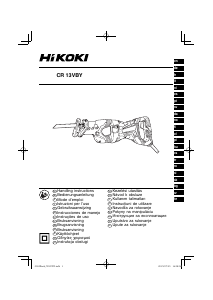


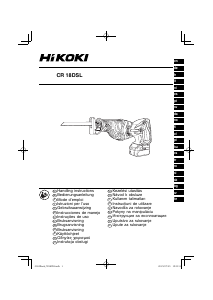
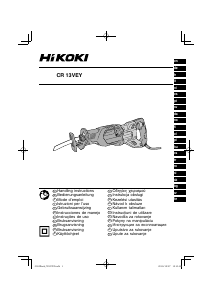
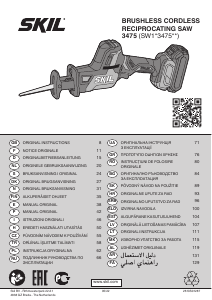
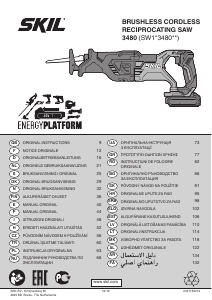
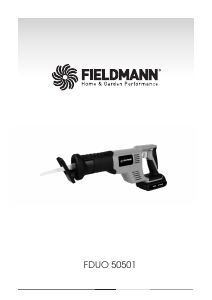
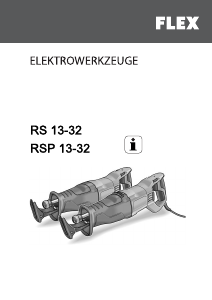

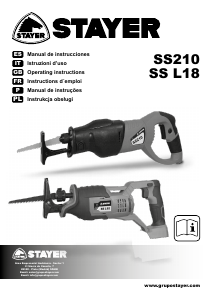
Dołącz do dyskusji na temat tego produktu
Tutaj możesz podzielić się swoją opinią na temat Hikoki CR 13VBY Piła szablasta. Jeśli masz pytanie, najpierw dokładnie przeczytaj instrukcję. Zapytanie o instrukcję można złożyć za pomocą naszego formularza kontaktowego.